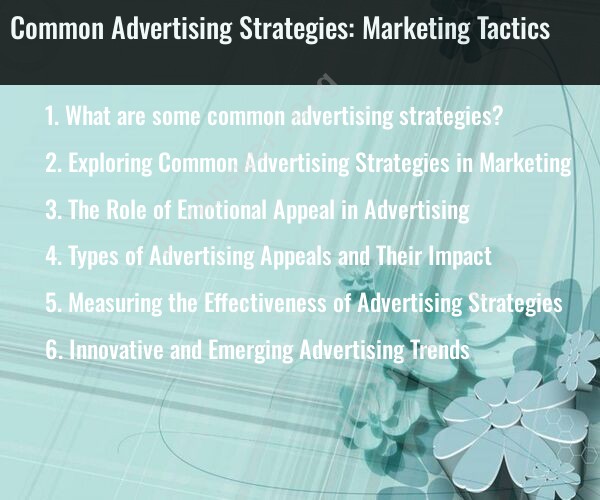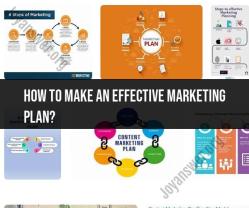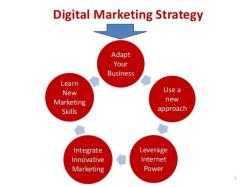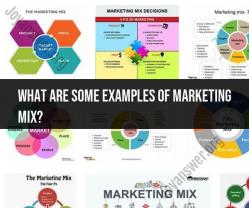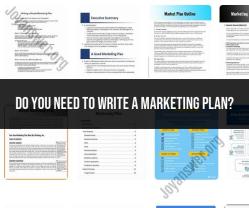What are some common advertising strategies?
Advertising strategies are essential for businesses to promote their products or services and reach their target audience. Here are some common advertising strategies used in marketing:
Social Media Advertising:
- Leveraging platforms like Facebook, Instagram, Twitter, and LinkedIn to create targeted ads that reach specific demographics and interests.
Content Marketing:
- Creating and sharing valuable, relevant content such as blog posts, videos, infographics, and more to attract and engage your audience.
Search Engine Marketing (SEM):
- Using paid search advertising, like Google Ads, to appear in search engine results for specific keywords and phrases.
Search Engine Optimization (SEO):
- Optimizing your website and content to improve organic search engine rankings, making it easier for users to find your site.
Email Marketing:
- Sending targeted emails to subscribers and potential customers to promote products, share news, and build customer relationships.
Influencer Marketing:
- Collaborating with influencers or individuals with a significant online following to promote your products or services.
Affiliate Marketing:
- Partnering with affiliates or other businesses to promote your products or services, with commissions paid for successful referrals.
Guerrilla Marketing:
- Using unconventional and often low-cost tactics to create memorable and attention-grabbing advertising campaigns.
Native Advertising:
- Creating ads that blend seamlessly with the content they appear alongside, providing a more natural and less intrusive user experience.
Display Advertising:
- Placing visual banner or video ads on websites, apps, or social media platforms to increase brand visibility.
Retargeting (Remarketing):
- Targeting ads specifically to users who have previously visited your website, encouraging them to return and make a purchase.
Video Marketing:
- Utilizing video content on platforms like YouTube or social media to engage and educate your audience.
Print Advertising:
- Placing ads in newspapers, magazines, brochures, and other printed materials to reach a more traditional audience.
Outdoor Advertising:
- Using billboards, transit ads, and other physical outdoor spaces to promote products or services.
Radio and Podcast Advertising:
- Running audio ads on traditional radio or in podcasts to reach listeners with relevant content.
Television Advertising:
- Airing television commercials on cable or broadcast networks to reach a wide audience.
Direct Mail Marketing:
- Sending physical promotional materials, such as postcards or catalogs, to a targeted mailing list.
Event and Sponsorship Marketing:
- Participating in or sponsoring events, trade shows, or community activities to promote your brand.
Cause Marketing:
- Aligning your brand with a charitable or social cause to demonstrate corporate responsibility and engage socially conscious consumers.
Word-of-Mouth Marketing:
- Encouraging satisfied customers to share their positive experiences and recommendations with others.
Experiential Marketing:
- Creating immersive and memorable brand experiences through events, interactive displays, or pop-up shops.
Successful advertising often involves a combination of these strategies, tailored to the specific needs of your business, target audience, and marketing goals. Additionally, measuring the effectiveness of your advertising campaigns through analytics and feedback is crucial for optimizing your marketing efforts.
Exploring Common Advertising Strategies in Marketing
Effective advertising involves employing a range of strategies to capture consumers' attention, convey a message, and influence their purchasing decisions. Here are some common advertising strategies used in marketing:
Emotional Appeal: Eliciting emotional responses like happiness, sadness, humor, or fear can create a strong connection with the audience and make ads more memorable.
Humor: Humor can lighten up serious topics, make ads more engaging, and increase brand recall.
Fear Appeal: Warning consumers about the negative consequences of not using a product or service can motivate them to take action.
Scarcity and Urgency: Creating a sense of limited availability or time pressure can lead to impulsive purchases.
Social Proof: Using testimonials, endorsements, and influencer marketing can build trust and credibility.
Celebrity Endorsements: Leveraging the popularity and influence of celebrities can increase brand awareness and credibility.
Storytelling: Weaving narratives and creating relatable characters can make ads more engaging and emotionally resonant.
Visual Appeal: Stunning visuals, captivating graphics, and high-quality production can capture attention and make ads more memorable.
Call to Action: Providing clear and compelling instructions can guide consumers towards the desired action, whether it's visiting a website, making a purchase, or signing up for a newsletter.
The Role of Emotional Appeal in Advertising
Emotional appeal plays a significant role in advertising effectiveness. By evoking emotions, advertisers can connect with consumers on a deeper level, make ads more memorable, and influence purchasing decisions. Emotions can drive motivation, shape perceptions, and influence behavior.
Types of Advertising Appeals and Their Impact
Different types of advertising appeals have varying effects on consumers:
Positive Emotions: Ads that evoke positive emotions like happiness, humor, or love can create a favorable impression of the brand and increase brand likability.
Negative Emotions: Fear appeal, for instance, can motivate action by highlighting the potential negative consequences of inaction.
Social Emotions: Appeals that tap into social emotions like belonging, acceptance, or social approval can be effective in promoting products or services that enhance social standing or self-esteem.
Measuring the Effectiveness of Advertising Strategies
Evaluating the effectiveness of advertising strategies is crucial for optimizing campaigns and maximizing ROI. Common metrics used to measure ad effectiveness include:
Brand Awareness: Tracking brand awareness measures like brand recognition and brand recall to assess the impact of advertising on consumer familiarity.
Ad Recall: Measuring the ability of consumers to remember specific elements of an ad, such as the brand name, tagline, or product features.
Website Traffic: Analyzing website traffic to determine whether ads are driving users to the brand's website.
Sales Conversion: Tracking sales figures and customer acquisition data to assess the direct impact of advertising on sales.
Social Engagement: Measuring social media engagement, such as likes, shares, and comments, to gauge audience interest and response to the advertising campaign.
Innovative and Emerging Advertising Trends
The advertising landscape is constantly evolving, with new technologies and trends emerging:
Programmatic Advertising: Utilizing algorithms and automation to buy and sell ad space in real-time, optimizing ad placements and targeting.
Interactive Advertising: Creating immersive and interactive experiences, such as augmented reality and virtual reality ads, to engage users and enhance brand experiences.
Social Media Advertising: Leveraging social media platforms to target specific audiences with personalized ads and engage with users through social media marketing campaigns.
Influencer Marketing: Collaborating with influencers who have established credibility and reach within specific target audiences to promote products or services.
Native Advertising: Integrating ads seamlessly into the user experience, creating a less disruptive and more engaging form of advertising.
By staying abreast of these trends and adopting innovative strategies, advertisers can effectively reach their target audience, enhance brand awareness, and drive business growth.
